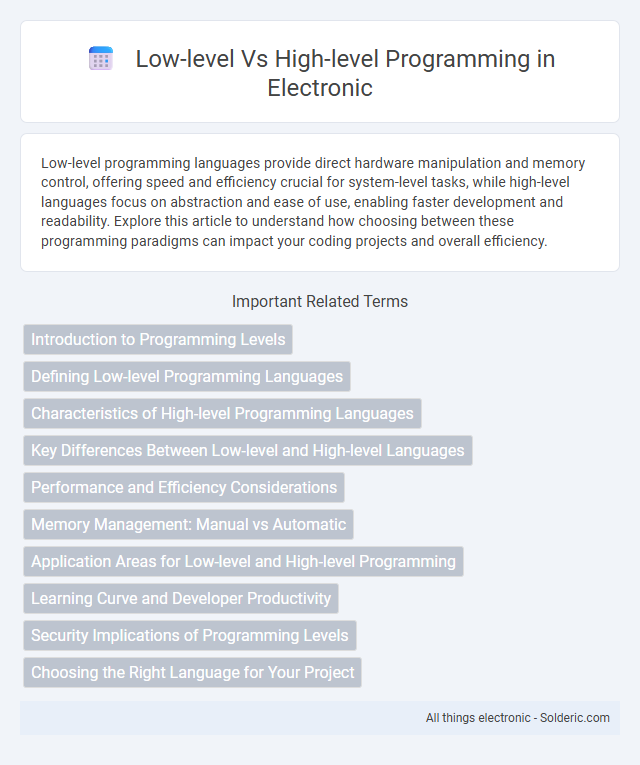Low-level programming languages provide direct hardware manipulation and memory control, offering speed and efficiency crucial for system-level tasks, while high-level languages focus on abstraction and ease of use, enabling faster development and readability. Explore this article to understand how choosing between these programming paradigms can impact your coding projects and overall efficiency.
Comparison Table
| Aspect | Low-level Programming | High-level Programming |
|---|---|---|
| Abstraction | Minimal, close to hardware | High, user-friendly syntax |
| Examples | Assembly, Machine Code | Python, Java, C# |
| Performance | Fast execution, efficient resource use | Generally slower due to abstraction |
| Portability | Low, hardware-specific | High, platform-independent |
| Ease of Learning | Complex, requires deep hardware knowledge | Easy to learn, intuitive |
| Use Cases | System programming, embedded systems | Web apps, software development, automation |
| Memory Management | Manual control | Automatic (garbage collection) |
Introduction to Programming Levels
Low-level programming languages, such as Assembly and machine code, provide direct hardware manipulation and high execution speed but require detailed knowledge of the computer architecture. High-level programming languages like Python, Java, and C++ use abstract syntax and built-in libraries to increase developer productivity and code readability. The distinction in programming levels influences performance optimization, ease of maintenance, and cross-platform compatibility.
Defining Low-level Programming Languages
Low-level programming languages are closely tied to computer hardware, providing direct control over memory and processor instructions through machine code or assembly language. These languages enable efficient manipulation of system resources, making them ideal for performance-critical applications such as operating systems and embedded systems. Understanding low-level programming helps you optimize software for speed and hardware compatibility by working closer to the machine's native language.
Characteristics of High-level Programming Languages
High-level programming languages feature strong abstraction, allowing you to write code closer to human language with simplified syntax and comprehensive libraries, enhancing development speed and readability. These languages support automatic memory management, portable code across different hardware platforms, and robust error handling mechanisms. Their design prioritizes ease of use, enabling developers to focus on complex problem-solving rather than intricate machine-specific details.
Key Differences Between Low-level and High-level Languages
Low-level programming languages, such as Assembly and machine code, offer direct hardware manipulation and efficient performance but require detailed knowledge of computer architecture. High-level languages like Python, Java, and C++ provide abstraction, making coding more user-friendly and faster for complex application development by handling memory management and system operations internally. Your choice depends on whether you prioritize control and speed or ease of use and rapid development in software projects.
Performance and Efficiency Considerations
Low-level programming languages, such as Assembly and C, offer superior performance and efficiency by providing direct hardware manipulation and minimal abstraction, which reduces execution overhead. High-level languages, like Python and Java, prioritize developer productivity and portability but introduce performance trade-offs due to runtime interpretation, garbage collection, and abstraction layers. Critical system components and performance-sensitive applications often rely on low-level languages for optimal resource control and execution speed.
Memory Management: Manual vs Automatic
Low-level programming languages like Assembly provide manual memory management, requiring developers to allocate and deallocate memory explicitly, which allows fine-grained control but increases the risk of memory leaks and pointer errors. High-level languages such as Python and Java implement automatic memory management through garbage collection, abstracting away memory allocation details to improve developer productivity and reduce bugs. The trade-off between manual and automatic memory management influences performance, safety, and ease of development in software engineering.
Application Areas for Low-level and High-level Programming
Low-level programming languages, such as Assembly and Machine Code, are predominantly used in system programming, embedded systems, and performance-critical applications like operating systems and device drivers due to their direct hardware manipulation capabilities. High-level programming languages, including Python, Java, and C#, excel in application development, web development, artificial intelligence, and enterprise software because they offer abstraction, ease of use, and extensive libraries. The choice between low-level and high-level programming hinges on the required control over hardware versus the need for rapid development and maintainability in various application domains.
Learning Curve and Developer Productivity
Low-level programming languages like Assembly offer fine-grained control over hardware but come with a steep learning curve due to complex syntax and manual memory management. High-level languages such as Python or Java abstract these details, enabling faster development and higher productivity even for beginners. Your choice impacts how quickly you can prototype and maintain code, balancing control against ease of use.
Security Implications of Programming Levels
Low-level programming languages offer granular control over hardware resources, which can lead to increased vulnerability if memory management errors like buffer overflows occur, exposing systems to security risks. High-level languages incorporate built-in safety features such as automatic memory management and strong typing, reducing common security flaws and enhancing code reliability. Understanding the security implications tied to programming levels is crucial for developers to implement effective safeguards against exploitation and maintain robust application security.
Choosing the Right Language for Your Project
Choosing the right programming language depends on project requirements, performance needs, and developer expertise. Low-level languages like C and Assembly offer fine-grained control and optimal performance for system programming and embedded devices, while high-level languages like Python, Java, and JavaScript enable faster development with extensive libraries for web, mobile, and enterprise applications. Evaluating factors such as execution speed, maintainability, and platform compatibility ensures selecting the most effective language for project success.
Low-level vs High-level programming Infographic

 solderic.com
solderic.com